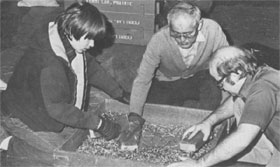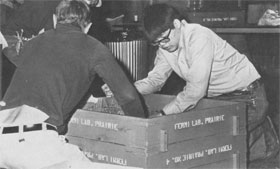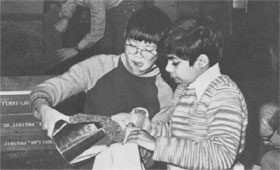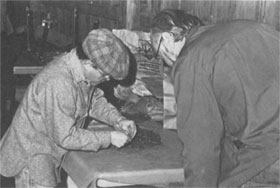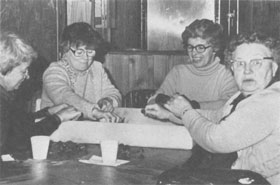Prairie Seeds/Physics Find Common Ground
Fooling Mother Nature may not be nice, but for her own sake, a Fermilab ecology project will do it anyway.
While most seeds are readying for spring sprouting Fermilab staffers and helpers have put some "special" seeds into hibernation for a few months. VSS (Very Special Seed) treatment is being accorded selected prairie plant seeds-grasses and flower varieties-planned for planting here in June. Seeds were sorted, separated from foreign materials and put to bed during Fermilab's third annual seed cleaning day Feb. 26.
1977 seed-cleaners needed little direction, Donaldson said. "Most were veterans; they knew exactly what to do."
After cleaning, seeds were settled down for a late winter's nap by stratification. The process will insure dormancy until planting in June. In a nutshell, stratifying consists of: 1) bagging seeds in cloth sacks, 2) soaking the sacks in water (in Fermilab's case, a discarded bathtub was used), 3) soaked sacks are individually rebagged in plastic utility bags, and 4) bundles are refrigerated at 38 degrees F.
Spring for these seeds will arrive in June. They will be defrosted, then dried by being spread out two to three inches deep on a concrete floor for four or five days.
Preceding planting will be a second biennial field burnoff supervised by the Fermilab fire protection unit. . The measure is necessary to give prairie grasses an edge against competing weeds. "Prairie plants are perennials with long, well-developed root systems," Donaldson said., "they can withstand fires which the weeds cannot."
The seeds will be used to plant from 16 to 20 acres on the northwest quarter of the main accelerator ring. Rudy Dorner's site operations crew will tackle the assignment with a special planting machine on loan from the Arboretum. About 16 acres of the 660 in the ring have been planted since 1974.
That year marked the launching of a Fermilab project to restore vanishing Illinois prairie on the high-energy physics research site. A demonstration plot adjoins Road D, opposite the buffalo pasture. Surrounded by a rail fence, the plot is a mini-version of the prairie intended for inside the main ring.
With man's help, the sample plot is kept virtually free of weeds. Plants there thrive more vigorously than in the large tracts within the main ring where nature's law -- survival of the fittest -- reigns.
Eventually, perhaps next year, Donaldson predicted, prairie plantings at Fermilab will yield seeds to complete the project
Tony Donaldson, an Accelerator Division engineer and chairman of Fermilab's Prairie Restoration Committee directed the project. He reported that 50 volunteers contributed over 200 hours in cleaning and stratifying seeds collected last fall. In October, 150 volunteer gleaners stalked the Morton Arboretum at Lisle, Gensberg-Markham (IL) Prairie and other scattered prairie plots for the precious seeds, seed pods and clusters.
A near-record 390 pounds were collected and bagged in the field. The paper bags were stored on site until cleaning day.
Collected were about 290 pounds of grass seed and 100 pounds of flower seeds. Of the grasses, Donaldson said, Big Blue Stem seeds totaled about 150 pounds, with Indian Grass totaling 130 pounds and 10 pounds of Switch Grass. Among the 20 varieties of flowers represented were Bottle Gentian, Blazing Stars, Compass Plant, Prairie Dock and Yellow Cone Flower. (In 1975, the harvest yielded about 250 pounds of seed: 190 pounds of grasses, 60 in flower seeds. Weather conditions-high winds blew seeds off stalks-a late harvest and fewer volunteers reduced the effort's effectiveness.)
Stems, sticks, stones and other debris were sifted from the seeds during the cleaning operation. It got underway at 9 a.m. in Kuhn's Barn, near the swimming pool. Fermilabbers working were Rene Donaldson, Technical Publications; Nancy Tweedie, Guest Office; Maury Goodman, E-401; John Nagy, E-95; and Dave Snyder, E-288; and Mrs. Richard Lundy and Mrs. Polly Cosgrove, whose husbands hold Neutrino and Accelerator assignments.
Other volunteers included students from York High School, Glenbard East High School, and Bryan Jr. High School (Elmhurst). Also, a half-dozen Boy Scouts came from Evanston and numerous area residents were drawn from surrounding towns. They were notified in advance through a mailing list maintained by Rene Donaldson.
Technical advice is provided by Ray Schulenberg, curator of the herbarium at Morton Arboretum and Robert Betz, Northeastern Illinois biology professor and a prairie authority. He heads an advisory committee guiding prairie restoration efforts at Fermilab.



